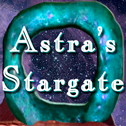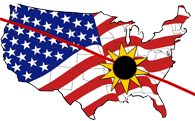Phenomena during a Total Solar Eclipse
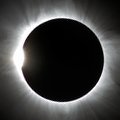
Find out about the April 8, 2024 eclipse from Astra's Eclipse Guide !
A total solar eclipse is a unique astronomical event. During totality, earth-based observers are able to make observations that are otherwise impossible without using special equipment. In fact, Einstein's theory of general relativity was tested and shown to be accurate using observations during a total solar eclipse. Astra's total solar eclipse guide provides a description of the astronomical terminology that is used to enable astronomers to discuss solar eclipse events, as well as a description of events to look for when observing a total solar eclipse.
Remember to protect your eyes and instruments from the blinding light of the Sun.
Always use adequate filters and check them regularly to ensure that there are no pinholes. Do not use telescopes or other instruments with filters that are placed behind the eyepiece. Instruments should always be shielded in front of the lens or mirrors of light gathering instruments. Do not use welding glass or cardboard filters in front of binoculars or other instruments. Eye damage can result from using these without experiencing painful sensations. The safest method of observing the Sun is though the use of projection. Take care, however, that any instruments set up for projection can not be tampered with by well-meaning folks or youngsters who may attempt to look through the eyepiece. Do not risk eye damage and protect imaging devices. They can also be damaged by the Sun. Do learn the principles of pinhole cameras and make your own instrument and test it before the total solar eclipse.
Don't waste precious moments of totality. Be sure you are familiar with your instrument if using special equipment. Protect your skin with sunscreen if you are planning to observe the eclipse from first to last contact. Please don't observe totality through the eyepiece of a camera. Know how long you can expect to experience totality from your location.
Astra says:
Enjoy! Enjoy! Enjoy!
Stages of a Solar Eclipse
First Contact
Partial eclipse begins. (1st contact) The Moon starts becoming visible over the Sun's disk. The Sun looks as if a bite has been taken from it. The bite gets bigger as the shadow of the moon encroaches over more of the Sun's disk.
Second Contact
At 2nd contact the total eclipse begins. The entire disk of the Sun is covered by the Moon. Observers in the path of the Moon's umbra may be able to see Baily's beads and the diamond ring effect, just before totality.
Totality (maximum eclipse)
The Moon completely covers the disk of the Sun. Only the Sun's corona is visible. This is the most dramatic stage of a total solar eclipse. At this time, the sky goes dark, temperatures can fall, and birds and animals often go quiet. The midpoint of time of totality is known as the maximum point of the eclipse. Observers in the path of the Moon's umbra may be able to see Baily's beads and the diamond ring effect, just after totality ends.
Third Contact
Total eclipse ends. (3rd contact) The Moon starts moving away, and the Sun reappears.
Fourth Contact
Partial eclipse ends. (4th contact) The Moon stops overlapping the Sun's disk. The eclipse ends at this stage for a specific location.
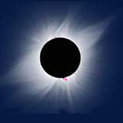
Total Solar Eclipse Phenomena
If you've never experienced totality, this stage of a total solar eclipse will surprise and delight you. As the eclipse begins, when the Moon takes the first bite out of the solar disk, there is no discernable effect without the aid of a magnifying instrument. As more of the solar disk is obscured, the temperature will begin to fall, although it is most notable when the Sun is about half hidden. Although the day still seems bright, a loss of light and heat becomes increasingly evident. The early and later stages of the eclipse will present a lot of bright sunlight, so remember your sunscreen if you want to observe the entire 2.5 hour show.
As it begins to grow dark, the bright planets will begin to appear. For those who watch the dance of the planets, the familiar evening or morning planetary lineup will be revealed, starting with Venus, Jupiter, Saturn, even Mars or the distant gas giants that aren't possible to detect without magnification. Even 1% of the sun's rays can cause blindness, so please don't stop using protection untill every direct glimmer of the Sun's surface is hidden.
Bailey's Beads
The phenomenon occurs about 10 to 15 seconds before and after totality, Baily's beads are little bead-like blobs of light at the edge of the Moon. The “beads” of light appear because the gaps in the mountains and valleys on the edge of the Moon's disk allow sunlight to pass through in some places but not others. The relief is significant enough that Earth-based observers are treated to a beautiful sight. Only one side of the disk will show Bailey's Beads.
Diamond Ring
As the Moon moves to cover the entire disk of the Sun, Baily's beads disappear, leaving one last bead a few seconds before totality. At this point in the eclipse, the Sun's corona forms a ring around the Moon. The ring around the Moon and the leftover Baily's bead give the appearance of a diamond ring. This the signature sight of upcoming total eclipse and many photos of them have been published.
Solar Chromosphere
This layer of the Sun’s atmosphere appears as a reddish glow that may only be seen for a few seconds after the diamond ring disappears. The word chromosphere means circle of color. It is very tenuous, and quite hot ~25000K. It is in the chromosphere that solar prominences occur. These are giant plumes of gas that glow in a bright magenta color. They are quite spectacular during totality.
Solar Corona
Like the chromosphere, the Sun's corona is only visible during the totality of a solar eclipse or by using special instruments. The corona surrounds the Moon's silhouette when the Sun's disk is totally covered. The word corona means crown and what a crown it is! Extending from the Sun for millions of kilometers (miles), it appears like a white mist that surrounds the eclipsed solar disk. We think of the sun as hot, but it is the solar corona where our life-giving Sun really heats up. Temperatures in the corona have been clocked up to 10 million K degrees. Here is where the ion plasma solar flares reach out from the Sun’s disk and speed through the solar system. (Flares originate below the photosphere surface.)
Shadow Bands
Shortly before and after totality, plain surfaces may show wavy lines of alternating light and dark moving across them, similar to the effect of light and dark waves of sunlight reflecting at the shallow bottom of a body of water. The shadow bands are the result of the light emitted from a thin sliver of the solar surface being refracted by Earth's atmosphere. These effects are caused by the motion of the water or atmosphere. A total eclipse that occurs on a windy day may not exhibit shadow bands. Total eclipse observers spread a large white sheet on the ground in an attempt to observe the effect just before or after totality.
Animal Behavior
Animals and plants can also be deeply affected by the dropping light level. Most of them respect the day/night cycle and have instinctive behavior that they follow on a daily basis. During an eclipse, some of animals will begin to exhibit their evening behaviors. Some night blooming flowers have been noted to give off their scent. Work horses may refuse to carry out their regular work tasks, some are reported to actually lie down in the middle of their assigned tasks. Cows have been noted to arrange themselves in a circle, each cow facing outward.
There is nothing like the totality of a solar eclipse. For US citizens, this may be the only time that this event may touch their lives. I cannot urge you more strongly to find out what happens when the Sun disappears from the sky in broad daylight.
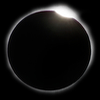
I had heard that viewing a total solar eclipse was a religious experience. I read that it changed your life forever. I knew that it was a unique event. I wasn't ready for the intensity of my emotions. I didn't know that I would be jumping up and down like a child, yelling at the top of my lungs--Diamond Ring! DIAMOND RING!!!!"
--Dawn Jenkins observation of the 1991 total eclipse from Los Barriles
Share Astra's Guide to the Total Solar Eclipse August 21, 2017 on Facebook
Navigate Astra's Total Solar Eclipse Guide
